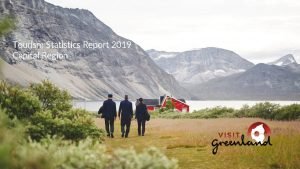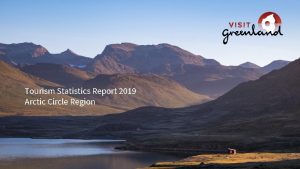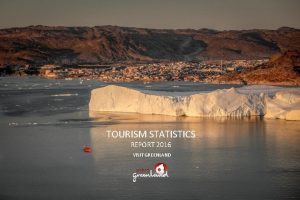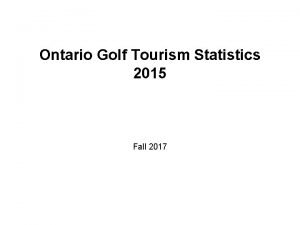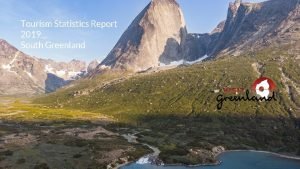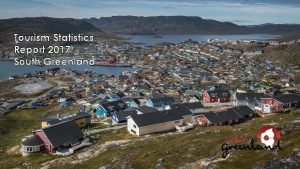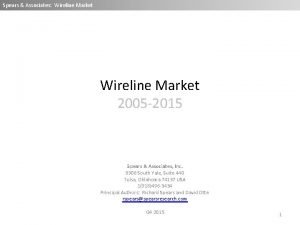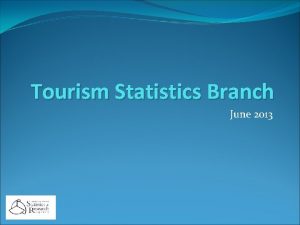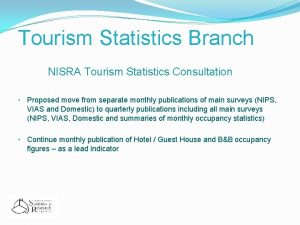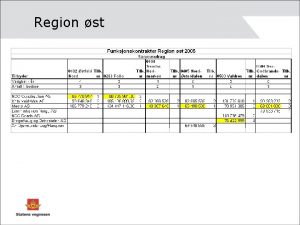Tourism Statistics Report 2017 Capital Region Introduction As









- Slides: 9

Tourism Statistics Report 2017 Capital Region

Introduction As explained in the national tourism statistics report 2017 the flight passenger data from 2017 unfortunately cannot be used to identify trends in the Greenlandic tourism development as it is not complete. Visit Greenland, Statistics Greenland Mittarfeqarfiit have joined forces to ensure a more complete registration in 2018. Thus this regional report primarily focuses on the overnight stay statistics and the cruise statistics. We recommend that this report is seen as a supplement to the national report as that is based on a larger data volume minimizing the statistical uncertainty. Furthermore the national report looks in depth at the latest tourism interviews conducted by two Visit Greenland interns from the tourism program at Aalborg University during July and August 2017. With a decline in the number of international overnight stays in Capital Region of -8. 7%, but 1, 351 more cruise passengers which is the equivalent of a growth of 9. 8% there are both negative and positive indicators for the tourism development in 2017. The tourist overnight stay statistics, the cruise statistics as well as feedback from Greenlandic tourism operators show that overall 2017 was a good year for tourism in Greenland. As the incomplete flight passenger data from this year could not be used we chose instead to ask 240 Greenlandic tourism operators about their 2017 season and their expectations for 2018. We received answers from a total of 82. The numbers on overnight stays show an overall growth of approximately 10% while the number of cruise passengers has increased by 13. 1%. Only 5. 5% of the tourism operators reported negative growth while the rest either had a season similar to 2016 or experienced growth. Globally 2017 has been one of the best years in recent times with a total growth of 7% with Europe as a region experienced a growth of 8%. The prognosis on the coming years points to a continued medium-high global growth of approximately 5%. Iceland is still a part of the growth elite and in 2017 the country experienced a growth in the number of international passengers of 24. 2%. It is expected that during 2018 more than 10 million passengers will pass through Keflavik. Despite the fact that Air Iceland Connect report a negative growth of -9. 7% on routes between Iceland Greenland from 2016 to 2017 the potential for Iceland-Greenland combination trips is still relevant to consider also by virtue of the feedback from many of the 292 land based tourists interviewed by Visit Greenland in July-August (please, see the national tourism report p. 28). Each region undeniably still has its challenges whether it’d be accessibility, over- or under-capacity in the high season, logistics and the like. However since 2014 there has been a relatively nice growth nationally and overall there is reason for continued optimism when it comes to the next few years.

Flight Passengers Travelling Out of Greenland via Nuuk Airport As mentioned in the introduction there has been incomplete registrations of the country of residence of the passengers in the course of 2017. With 53% nonregistered Nuuk Airport has been especially affected for different reasons, but in 2018 the goal is to keep the non-registration at less than 5%. All growth rates are listed in grey because none of the country segments are larger than 1, 000 individuals thus even a difference of a few individuals from year to year will cause an exaggerated fluctuation in the growth rate (both positive and negative growth). Therefore the growth rates should be taken with great reservations. Other reservations to be taken: Approximately 90% of all tourists travel to and from the region via Kangerlussuaq and not directly between Iceland Nuuk. The graph to the left only shows passengers on direct flights from Nuuk to Iceland the equivalent of only approximately 10% of all travellers to and from Ilulissat Airport. Due to the reservations mentioned above Visit Greenland does not recommend that the numbers from the graph on the left be used to identify trends in tourism development in Capital Region. For this purpose the overnight stay statistics is a more credible source.

Number of Overnight Stays in the Region A growth of -8. 7% in the number of tourist overnight stays in the region is not positive. Growth rates for all country segments under 1, 000 overnight stays are listed in grey to indicate that special reservations should be taken, as even a difference of a few overnight stays from one year to the next can cause disproportionate percentage differences. The only major country segment that has growth is the United States with 30. 3%, which corresponds to 260 overnight stays. Iceland with less than 1, 000 nights is a slightly smaller segment with a growth of 17. 2%. Many Icelandic companies operate in Nuuk, and many of the Icelandic nights are assumed to be business-related. Larger hotels in the region regularly share their data on country segments – other than those listed in the graph – they observe to have good growth rates and thus potential for an increased demand. Most accommodations only use the predefined countries of residence listed on the registration form from Statistics Greenland (including ’Other Europe’ and ‘Other countries’), while others typical the larger hotels with their own booking systems tend to register all countries of residence. Visit Greenland estimates that the accommodations in the region that do submit registrations to Statistics Greenland represent approximately 80% of all overnight stays in the accommodations in the region. We do not have data on the number of overnight stays via airbnb. com, but the number is most likely growing from year to year, as the number of housing in Nuuk is increasing on the portal.

Number of Individual Guests in the Region Where there is a -8. 7% negative growth in the number of individual tourist stays sold in the region, the negative growth in the number of individual foreign guests is only -0. 9%. It is close to the status quo. In practice, the difference must mean that every visitor on average bought fewer overnight stays each compared to 2016. There has been a nice increase for resident guests of 17. 2%, but a decrease of -8. 3% on the important Denmark segment, which corresponds to 368 people resident in Denmark. The positive growth for Other Europe of 6. 8% equals 35 people, and the positive growth of 32. 9% from the United States is equivalent to 113 people. The smaller a segment the bigger the difference caused by a single person from year to year. The Danish segment is the only one with a size large enough (over 1, 000 persons) to show more general trends, but again, only from one year to the next. Over a 10 -year period this is how the Danish segment looks: If one applies a trend line using ‘moving average’ one will see an increasing trend over the 10 -year period. Thus it is always better to look at larger segments over a longer period of time in order to identify regular trends.

Occupancy Rate in Accommodations in the Region The season pattern on Capital regio in relation to occupancy rate (how many room are rented out of the total capacity in the graph to the left) is quite different than the other regions. There is a significant knock on the curve in the month of July that for the other regions is generally the month with the highest occupancy rate. A part of the explanation is that the large part of the guests in the largest accommodations in the region are residents in the region attending meetings, conferences etc. and this kind of events usually do not take place in the month of July. The graph to the right shows that the decline in July is due to a lack of booking from Greenlandic citizens and tourists alike. The explanation of the lack of tourists in the accommodations in the region in July is unclear at this point, but it is obvious that this overcapacity should be utilized better in the long run. It is obvious among other things to create partnerships between relevant tourist operators for campaigns aimed at utilizing the July potential.

Number of Cruise Passengers in the Region 2017 vs 2016 The graph to the left: A good growth of 32. 2% in the number of passengers on cruise ships that called on Nuuk in 2017 which correlates to 3, 494 passengers. However there were 2, 143 fewer passengers on ships that called on Paamiut which is a negative growth of -72. 4% In the region combined that correlates to a growth of 9. 8% (1, 351 passengers) which is a satisfactory result that is in line with the national result of 13. 1%. As this type of data only reaches back to 2015 we cannot determine trends over a longer period of time, but data on the number of cruises according to pax category (the graph to the right), we can see that the schedule of the cruise lines change quite a lot from year to year thus there seems to be certain natural fluctuations in the business. The cruise lines are good at retaining most of the turnover in terms of product offerings for their passengers, but there is still an untapped potential for additional sales when the guest are ashore. Be it tour products, cultural offers and events or sale of arts and crafts and souvenirs. If you sell souvenirs, arts and crafts and other merchandise at stalls and the like it is important to make it easy for the tourists to pay. Thus it might be relevant to look into mobile payment options for credit cards. One can rent a small mobile credit card terminal from nets. dk for circa 350 DKK/month and circa 115 DKK/month in a fixed fee for international card transactions. Please write lumholt@visitgreenland. com for more info.

Number of Port Calls in Capital Region According to Passenger Capacity 2015 -2017 As for the number of port calls in the region for ships according to the 4 pax (passenger) capacity categories (0 -250, 251 -500, 501 -1200 and 1200+), you can observe that in the smallest category (0 -250 pax), there has been a gradual growth from 14 to 20 calls during the 3 -year period. For the second smallest category (251 -500 pax), the level has been quite stable at around 9 calls per year. For the second largest category (501 -1200 pax), there has been a gradual growth from 9 to 19 calls. For the largest category (1, 200+ pax), there have been no calls during the 3 -year period. From historic data we know that the biggest 1200+ pax ships rarely sail further north than Qaqortoq which is due to the risk of colliding with big icebergs, as only few of these ships have ice strengthened hulls. In the cruise business fluctuations from year to year are natural, and we do not have isolated data over a long period of time on Capital Region W and over the 3 -year period there are both positive and negative indications. A 9. 8% increase from 2016 to 2017 in the number of passengers on ships in the region is possibly the best short term indicator we identify. In the future it will be interesting to look at data on a 10 year period on the number of port calls or the number of passengers in the region in order to identify real trends.

Final Thoughts As mentioned earlier the flight passenger data cannot be used to identify trends in the tourism development for the region, especially in a year with insufficient registrations. Data from the accommodations indicate a very positive development with growth well above 10%. Cruise data shows a mixed picture and some fluctuations that seem natural in a historical perspective. In the short term, the development of a 9. 8% growth in the number of passengers who visited the region was a positive indicator which hopefully is a continuing trend over a number of years. There is a lot of talk about new extended airports these years, and if the 2, 200 m track in Nuuk is realized, airlines beyond Air Greenland will be able to offer routes to Nuuk from Iceland, Europe and perhaps North America. This will open up a commercial competition with, if possible, more airlines than the current ones. Recently, plans have been announced for the establishment of several hotels in Nuuk, as the extension of Nuuk airport seems likely to be realized. Such a possible synergy is obviously not complete until tours and other experience products are developed further, as flight seats and beds alone are not a ‘reason to go’. There is definitely an untapped potential in the surplus capacity of the accommodations in the month of July which has been the case for many years. It is relevant to continue initiatives – in collaboration between hotels, travel agencies and tour operators – with special offers in this period, as the month of July is the absolute high season in every other region in Greenland. Visit Greenland Capital Region Business Council work well together on the development of Nuuk as a tourist destination, and Capital Region Business Council continually works to increase the synergy between relevant operators in the region – including startups – which is very positive. Finally we wish you all a successful 2018 tourism season and look forward to a mutually beneficial cooperation. Best regards Visit Greenland Completed by senior consultant in market research, Mads Lumholt
